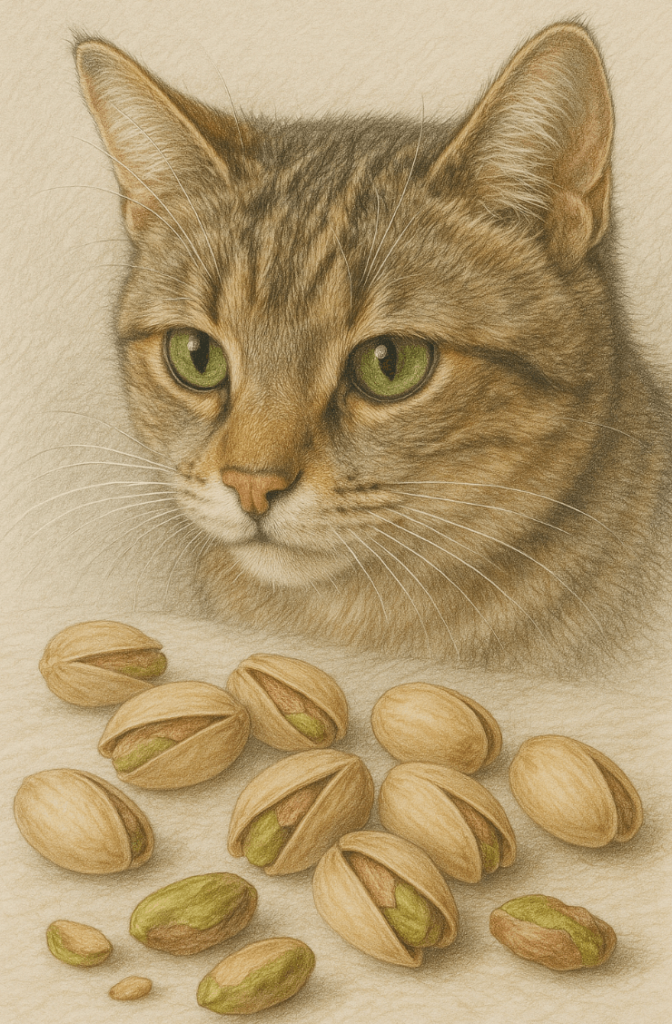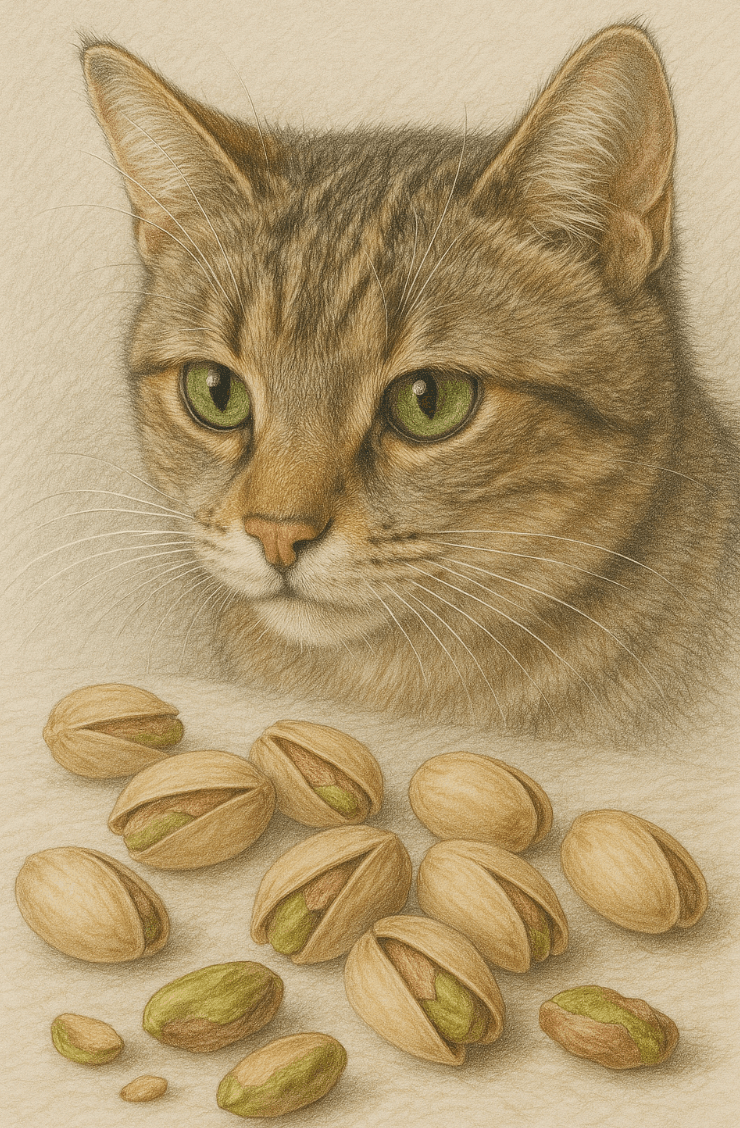Can Cats Eat Pistachios?
When it comes to feeding your feline friend, it’s natural to wonder which human foods are safe for them to eat. Pistachios, with their rich flavor and nutritional benefits for humans, might seem like a tempting treat to share with your cat. However, cats have unique dietary needs and sensitivities that differ greatly from ours. While pistachios aren’t inherently toxic to cats, they come with certain risks and considerations that every pet owner should be aware of. In this blog post, we’ll explore whether cats can safely eat pistachios, potential dangers, and healthier alternatives to keep your furry companion happy and healthy.
Potential Risks of Feeding Pistachios to Cats
While pistachios may seem harmless, they pose several risks that could harm your cat if consumed in large quantities or without caution. Understanding these risks is crucial before offering any human food to your pet.
High Fat Content:
Pistachios are high in fats, which can upset a cat’s digestive system and potentially lead to pancreatitis if consumed excessively.Salt and Seasonings:
Many store-bought pistachios are salted or flavored, which can be harmful to cats and lead to sodium toxicity or other health issues.Choking Hazard:
The hard shells or small pieces of pistachios can pose a choking risk, especially for curious cats who may try to swallow them whole.Allergic Reactions:
Some cats may have allergic reactions to nuts, including pistachios, resulting in symptoms like itching, swelling, or difficulty breathing.Difficulty Digesting:
Cats lack the enzymes needed to break down plant-based proteins, making pistachios difficult for them to digest properly.
These risks highlight why pistachios should be approached with caution and ideally avoided as a regular treat for your cat.
Healthier Alternatives to Pistachios for Cats
If you’re looking to spoil your cat with a tasty snack, there are plenty of safer and more nutritious options than pistachios. These alternatives cater to your cat’s carnivorous nature while providing essential nutrients.
Cooked Chicken (Plain):
Plain, unseasoned cooked chicken is a protein-rich treat that most cats love and can safely enjoy in moderation.Pumpkin Puree:
Unsweetened pumpkin puree aids digestion and can help with hairballs, making it a healthy option for cats.Freeze-Dried Liver Treats:
These treats are packed with nutrients and satisfy your cat’s craving for meaty flavors.Small Pieces of Fish (Boneless):
Boneless, cooked fish like salmon or tuna provides omega-3 fatty acids but should be given sparingly due to mercury concerns.Catnip or Cat Grass:
These natural options offer enrichment and stimulation without posing any health risks.
By choosing these alternatives, you can provide your cat with treats that align with their dietary needs and preferences.
Check this guide 👉Can Cats Eat Cherries? Best 7 Expert Tips!
Check this guide 👉Can Cats Eat Peas? Best 7 Expert Tips!
Check this guide 👉Can Cats Eat Lettuce? Best 7 Expert Tips!

Safe Foods for Cats | Foods to Avoid for Cats |
|---|---|
Plain cooked chicken | Salted or seasoned pistachios |
Unsweetened pumpkin puree | Onions and garlic |
Freeze-dried liver treats | Chocolate |
Boneless, cooked fish | Grapes and raisins |
Catnip or cat grass | Alcohol |
Signs Your Cat May Have Eaten Pistachios
If your cat accidentally consumes pistachios, it’s important to watch for signs of distress or discomfort. Early detection can prevent minor issues from escalating into serious health problems.
Vomiting or Diarrhea:
These symptoms often indicate digestive upset caused by consuming inappropriate foods like pistachios.Excessive Drooling:
Drooling can signal nausea or irritation in the mouth or throat after eating something harmful.Lethargy or Weakness:
A sudden lack of energy may suggest your cat is feeling unwell due to ingesting pistachios.Swelling or Itching:
Allergic reactions to nuts can cause visible swelling or excessive scratching.Difficulty Breathing:
In severe cases, an allergic reaction may lead to respiratory distress, requiring immediate veterinary attention.
Recognizing these signs early allows you to act quickly and protect your cat’s health.
Tips for Introducing New Foods to Your Cat
Introducing new foods to your cat requires care and consideration to avoid adverse reactions. Follow these tips to ensure a safe and positive experience.
Consult Your Veterinarian First:
Always seek professional advice before offering any unfamiliar food to your cat.Start with Small Amounts:
If approved by your vet, introduce tiny portions of the new food to monitor how your cat reacts.Observe for Allergies or Sensitivities:
Watch for signs of discomfort, such as itching, vomiting, or diarrhea, after trying new foods.Stick to Cat-Specific Treats:
Opt for treats specifically formulated for cats rather than sharing human snacks.Avoid Toxic Ingredients:
Be mindful of ingredients like salt, sugar, spices, or artificial additives that can harm your cat.
By following these guidelines, you can minimize risks and make informed decisions about your cat’s diet.
Common Mistakes to Avoid When Feeding Cats Human Food
Feeding cats human food can be risky if done incorrectly. Avoid these common mistakes to keep your cat safe and healthy.
Assuming All “Healthy” Foods Are Safe:
Just because a food is nutritious for humans doesn’t mean it’s safe for cats; always double-check before sharing.Ignoring Portion Sizes:
Even safe foods can cause issues if given in excess; moderation is key.Forgetting About Additives:
Seasonings, sugars, and preservatives in human foods can harm cats and should be avoided entirely.Not Monitoring Reactions:
Failing to observe your cat after introducing a new food can delay treatment for potential adverse effects.Offering Foods Out of Convenience:
Sharing table scraps may seem easy, but it’s better to provide species-appropriate snacks designed for cats.
Avoiding these mistakes ensures your cat enjoys a diet that supports their unique needs.
Understanding Your Cat’s Nutritional Needs
Cats are obligate carnivores, meaning their bodies require specific nutrients found primarily in animal-based proteins. Understanding their dietary requirements helps you make informed decisions about their meals and treats.
High Protein Requirement:
Cats thrive on diets rich in animal protein, which provides essential amino acids like taurine for heart and eye health.Limited Carbohydrate Tolerance:
Unlike humans, cats have limited ability to process carbohydrates, making grain-heavy foods unsuitable for them.Importance of Hydration:
Cats often don’t drink enough water, so wet food or moisture-rich treats can help maintain hydration.Essential Fatty Acids:
Omega-3 and omega-6 fatty acids support skin, coat, and overall health, but should come from animal sources rather than nuts.Avoiding Plant-Based Proteins:
While some plants offer protein, cats lack the enzymes needed to efficiently digest and utilize them.
Meeting these nutritional needs ensures your cat remains healthy and energetic throughout their life.
Fun Ways to Enrich Your Cat’s Diet Without Risky Foods
Enhancing your cat’s diet doesn’t have to involve risky human foods. Here are some fun and safe ways to add variety to their meals while keeping them entertained.
Interactive Feeders:
Puzzle feeders or treat-dispensing toys encourage mental stimulation and slow eating habits.Homemade Cat Treats:
Simple recipes using cat-safe ingredients like cooked chicken or fish let you control exactly what goes into their snacks.Rotating Flavors:
Switching between different flavors of high-quality commercial cat food keeps mealtime exciting.Fresh Water Stations:
Providing multiple water sources or a flowing water fountain encourages hydration.Herbal Enrichment:
Cat-safe herbs like catnip or valerian root offer sensory stimulation without posing health risks.
These ideas allow you to enrich your cat’s diet and lifestyle without compromising their safety.
Frequently Asked Questions About Cats and Pistachios
Are pistachios toxic to cats?
While not highly toxic, pistachios can still cause digestive upset, choking hazards, or allergic reactions in cats.
What should I do if my cat eats pistachios?
Monitor your cat closely for symptoms of illness and contact your veterinarian if you notice any concerning signs.
Can kittens eat pistachios?
Kittens are more vulnerable to digestive issues and should never be given pistachios or similar foods.
How much pistachio is too much for a cat?
Even a small amount can upset a cat’s stomach, so it’s best to avoid giving them pistachios altogether.
Are unsalted pistachios safe for cats?
While unsalted pistachios are less harmful than salted ones, they still carry risks and are not recommended for cats.
Prioritizing Your Cat’s Health Over Curiosity
While it’s tempting to share our favorite snacks with our feline companions, it’s essential to prioritize their health and well-being. Pistachios, though delicious for us, are not suitable treats for cats due to their high fat content, potential allergens, and choking hazards. By understanding what foods are safe and nutritious for your cat, you can ensure they stay happy, healthy, and thriving. Remember, a balanced diet tailored to their needs is the foundation of a long and joyful life together.
Cat Fever Treatment: Best 7 Expert Tips! Discover expert advice on identifying, managing, and treating fever in cats to ensure their quick recovery and well-being.
Understanding Meloxicam for Cats: Best 7 Expert Tips! Learn how to safely administer meloxicam, manage side effects, and ensure your cat's comfort with expert advice on feline pain relief.
Amoxicillin for Cat UTI: Best 7 Expert Tips! Discover safe usage, dosage guidelines, and expert advice on treating feline urinary tract infections effectively with amoxicillin.
Understanding Cat Cancer Treatment: Best 7 Expert Tips! Discover expert advice on managing feline cancer, from early detection to treatment options, ensuring your cat’s health and comfort.





